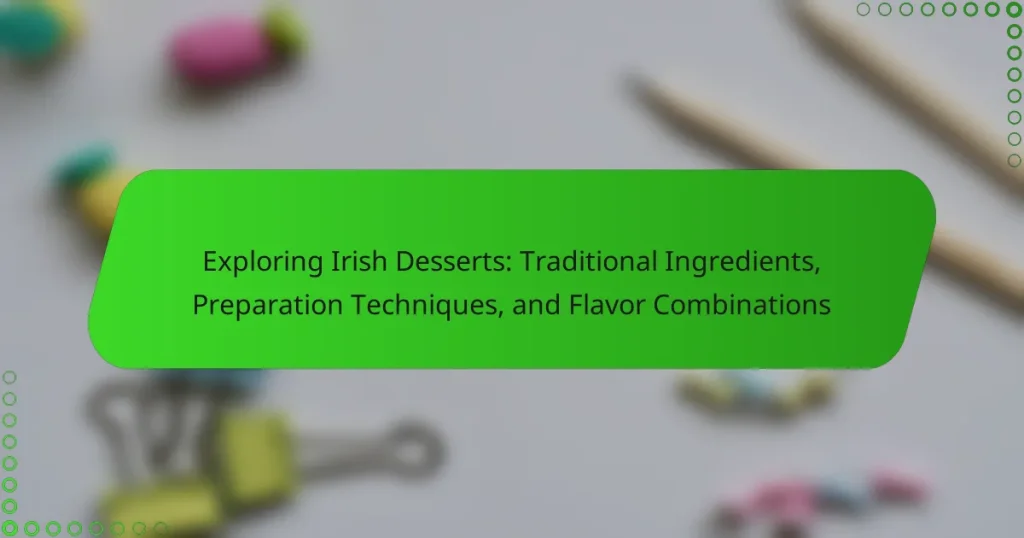Irish desserts are a reflection of traditional culinary practices, characterized by rich flavors and comforting textures derived from key ingredients such as dairy, fruits, and locally sourced produce. Common preparation techniques include baking, boiling, and steaming, which enhance the unique flavors found in dishes like bread and butter pudding and apple tart. Flavor combinations such as chocolate and stout, whiskey and caramel, and apple with cinnamon are prevalent, showcasing the depth of Ireland’s agricultural heritage. Seasonal ingredients play a crucial role in the creation of these desserts, emphasizing their rustic charm and hearty satisfaction.

What are the key characteristics of Irish desserts?
Irish desserts are characterized by their use of traditional ingredients, rich flavors, and comforting textures. Common ingredients include dairy, particularly cream and butter, as well as fruits like berries and apples. Desserts often feature simple preparation techniques, emphasizing home-cooked warmth. Popular examples include bread and butter pudding, which showcases stale bread and custard. Irish desserts frequently balance sweetness with a hint of saltiness, enhancing flavor complexity. Many recipes reflect Ireland’s agricultural heritage, utilizing locally sourced produce. Seasonal ingredients often play a vital role in dessert creation. Overall, Irish desserts embody a blend of rustic charm and hearty satisfaction.
How do traditional Irish desserts differ from other desserts?
Traditional Irish desserts often emphasize simple ingredients and rustic flavors. They typically feature staples like oats, dairy, and seasonal fruits. Common desserts include bread pudding, apple tart, and soda bread with sweet toppings. These desserts often have a hearty, comforting quality. In contrast, many other desserts worldwide may use exotic ingredients or elaborate techniques. Traditional Irish desserts are often less sweet than their global counterparts. They focus on natural flavors rather than heavy frosting or rich sauces. This approach reflects Ireland’s agricultural heritage and resourcefulness in using available ingredients.
What unique ingredients are commonly used in Irish desserts?
Unique ingredients commonly used in Irish desserts include brown soda bread, Irish whiskey, and buttermilk. Brown soda bread adds a hearty texture to desserts like bread pudding. Irish whiskey is often used in sauces and cakes, enhancing flavors with its distinct taste. Buttermilk contributes to the moistness and richness of various desserts, such as cakes and scones. Additionally, ingredients like currants and raisins, often found in traditional fruit cakes, provide natural sweetness and depth. These unique ingredients reflect Ireland’s culinary heritage and regional flavors.
How do cultural influences shape Irish dessert recipes?
Cultural influences shape Irish dessert recipes through the integration of local ingredients and historical practices. Traditional Irish desserts often feature staple ingredients like potatoes, oats, and dairy. These ingredients reflect Ireland’s agricultural heritage and availability. Historical influences, such as British and French culinary traditions, have introduced new techniques and flavors. For example, the use of cream in desserts is influenced by the dairy farming practices in Ireland. Additionally, the celebration of festivals and holidays often dictates dessert choices, such as the use of rich fruitcakes during Christmas. These cultural elements create a diverse array of desserts that tell the story of Ireland’s culinary evolution.
Why are traditional ingredients important in Irish desserts?
Traditional ingredients are important in Irish desserts because they reflect cultural heritage and regional identity. These ingredients often include items like soda bread, buttermilk, and Irish whiskey. Their use connects modern recipes to historical practices. Traditional ingredients also enhance flavor profiles unique to Irish cuisine. For example, Irish cream adds richness and depth to desserts. Additionally, these ingredients support local agriculture and promote sustainability. Using them helps preserve culinary traditions passed down through generations. In essence, traditional ingredients are vital for authenticity and cultural significance in Irish desserts.
What role do dairy products play in Irish dessert preparation?
Dairy products are essential in Irish dessert preparation. They contribute creaminess and richness to various desserts. Ingredients like butter, cream, and buttermilk are commonly used. Butter enhances flavor and texture in cakes and pastries. Cream is vital for making traditional desserts like Irish cream cheesecake. Buttermilk adds tanginess to baked goods like soda bread and pancakes. These dairy products are often sourced from local farms, ensuring freshness. Their use reflects Ireland’s agricultural heritage and culinary traditions.
How do seasonal fruits contribute to the flavor of Irish desserts?
Seasonal fruits enhance the flavor of Irish desserts by providing freshness and natural sweetness. These fruits, such as berries, apples, and rhubarb, are often used in traditional recipes. Their vibrant flavors complement rich ingredients like cream and butter. Seasonal fruits also add acidity, balancing sweetness in desserts. For example, tart berries can cut through the richness of a creamy dessert. The availability of local fruits ensures optimal ripeness and flavor. This connection to local produce is a hallmark of Irish culinary tradition. Ultimately, seasonal fruits play a crucial role in defining the taste of Irish desserts.

What are the common preparation techniques for Irish desserts?
Common preparation techniques for Irish desserts include baking, boiling, and steaming. Baking is often used for cakes and pastries, such as soda bread and apple tart. Boiling is a technique utilized for puddings, like bread and butter pudding. Steaming is commonly applied in the preparation of traditional desserts such as Christmas pudding. These methods enhance flavors and textures unique to Irish cuisine. Each technique reflects the rich culinary heritage of Ireland.
How is baking traditionally approached in Irish dessert making?
Baking in Irish dessert making traditionally emphasizes simplicity and the use of local ingredients. Commonly used ingredients include flour, sugar, butter, and dairy products. Traditional methods often involve mixing, creaming, and baking in a straightforward manner. Many Irish desserts are baked in a single pan, like cakes or sodas. Recipes often highlight seasonal fruits, such as apples and berries. Baking techniques also reflect cultural influences, such as those from British and European traditions. A notable example is the use of buttermilk in soda bread and cakes. This approach results in moist, flavorful desserts that celebrate Irish heritage.
What specific methods are used to create classic Irish cakes?
Classic Irish cakes are typically created using methods such as creaming, folding, and baking. The creaming method involves beating butter and sugar together until light and fluffy. This process incorporates air, which helps the cake rise. Next, eggs are added one at a time to maintain the emulsion.
Folding is often used to incorporate dry ingredients, like flour, along with any additional flavorings, such as spices or fruits. This technique ensures a light texture without deflating the batter.
Baking is then performed in a preheated oven, usually at moderate temperatures, ensuring even cooking. Popular Irish cakes may also involve soaking dried fruits in tea or whiskey for added flavor. These traditional methods reflect the rich culinary heritage of Ireland.
How do cooking techniques vary for different types of Irish desserts?
Cooking techniques for different types of Irish desserts vary significantly. For example, baking is essential for traditional desserts like soda bread and cakes. Boiling is commonly used for dishes such as spiced beef and some puddings. Steaming is often employed for sponge cakes and Christmas puddings. Frying is characteristic of desserts like apple fritters and doughnuts. Each technique affects the texture and flavor of the dessert. Baking typically results in a light and airy texture. Boiling can create a denser consistency in puddings. Steaming retains moisture and enhances flavors in sponge cakes. Frying adds a crispy exterior while keeping the inside soft. These variations reflect the diverse culinary traditions within Irish dessert preparation.
What is the significance of presentation in Irish desserts?
Presentation in Irish desserts is significant as it enhances the overall dining experience. A visually appealing dessert attracts attention and stimulates appetite. Traditional Irish desserts often incorporate vibrant colors and textures. This reflects the rich cultural heritage of Ireland. Attention to detail in presentation showcases craftsmanship. It also honors the ingredients used, elevating their perceived value. Moreover, well-presented desserts encourage sharing and social interaction. In Irish culture, food presentation is a form of hospitality and pride.
How do traditional serving styles enhance the dining experience?
Traditional serving styles enhance the dining experience by creating a sense of authenticity and cultural connection. They often involve communal sharing, which fosters a warm and inviting atmosphere. For example, serving dishes family-style encourages interaction among guests. This method allows diners to engage with one another while enjoying the meal. Additionally, traditional presentations often highlight the ingredients’ visual appeal. A well-arranged dessert can stimulate appetite and enhance enjoyment. Historical practices in Irish dining, such as serving bread and butter on wooden boards, evoke nostalgia and tradition. These elements contribute to a memorable dining experience that transcends mere consumption.
What garnishes are typically used to elevate Irish desserts?
Common garnishes used to elevate Irish desserts include whipped cream, fresh berries, and chocolate shavings. Whipped cream adds a light, airy texture that complements rich desserts. Fresh berries provide a burst of color and tartness, enhancing flavor profiles. Chocolate shavings contribute a decadent touch, appealing to chocolate lovers. Other garnishes like caramel sauce and nuts can also enhance the visual and taste experience. These garnishes are often selected for their ability to balance sweetness and add contrast. They reflect traditional Irish flavors and presentation styles.

What are popular flavor combinations in Irish desserts?
Popular flavor combinations in Irish desserts include chocolate and stout, often found in cakes. Another combination is whiskey and caramel, commonly used in sauces and puddings. Vanilla pairs well with traditional Irish cream in various desserts. Apple and cinnamon are classic flavors in Irish tarts and crumbles. Lemon and ginger add a refreshing touch to many sweet dishes. These combinations reflect the rich culinary heritage of Ireland. They often incorporate local ingredients, enhancing the overall flavor profile.
How do flavors complement each other in traditional Irish sweets?
Flavors in traditional Irish sweets complement each other through a balance of sweetness, acidity, and richness. Common ingredients like brown sugar and treacle provide deep sweetness. This sweetness is often balanced with tart fruits such as raspberries or blackcurrants. Cream and butter add richness, enhancing the overall flavor profile. Spices like cinnamon and nutmeg introduce warmth and complexity. The use of oats and nuts adds texture, creating a multi-dimensional tasting experience. Traditional recipes often blend these elements to achieve harmony. For example, the combination of sweet and tart in a berry tart highlights contrasting flavors effectively. This balance is essential in creating enjoyable desserts that reflect Ireland’s culinary heritage.
What are some classic pairings of ingredients in Irish desserts?
Classic pairings of ingredients in Irish desserts include whiskey and chocolate. This combination enhances the richness of chocolate dishes. Another classic pairing is cream and fruit, often seen in trifles and cheesecakes. The cream adds a smooth texture to the tartness of the fruit. Additionally, brown bread and butter are frequently used together in traditional desserts. This pairing provides a hearty base for sweet toppings. Finally, honey and oats create a wholesome flavor in various baked goods. These pairings reflect traditional Irish flavors and culinary practices.
How do spices and herbs enhance the taste of Irish desserts?
Spices and herbs enhance the taste of Irish desserts by adding depth and complexity. Commonly used spices like cinnamon and nutmeg provide warmth and sweetness. Herbs such as mint can introduce a refreshing contrast to rich flavors. These additions create a balance between sweetness and savory elements. For example, cinnamon is often used in apple tarts, complementing the fruit’s natural sugars. Nutmeg is a key ingredient in traditional Irish Christmas pudding, enriching its flavor profile. The use of these spices and herbs reflects Ireland’s culinary history and local produce. Overall, they elevate the sensory experience of desserts, making them more enjoyable.
What modern twists can be found in contemporary Irish desserts?
Contemporary Irish desserts feature modern twists such as innovative flavor combinations and alternative ingredients. Chefs are incorporating global influences, blending traditional Irish flavors with exotic spices. For example, soda bread is now used in dessert forms like bread pudding with chocolate and orange zest. Additionally, classic desserts like apple tart are being reimagined with contemporary presentations and components, including salted caramel and whipped cream.
Modern techniques, such as sous-vide cooking, are also being applied to traditional recipes. This method enhances flavor and texture, allowing for creative interpretations of desserts like custards and creams. The use of locally sourced, seasonal ingredients remains essential, but chefs are exploring new pairings, such as rhubarb with ginger or whiskey-infused desserts.
These modern twists reflect a blend of tradition and innovation, appealing to contemporary palates while honoring Irish heritage.
How are traditional recipes being adapted for modern palates?
Traditional recipes are being adapted for modern palates by incorporating contemporary ingredients and techniques. Chefs are experimenting with alternative sweeteners, such as agave or coconut sugar, to reduce refined sugar usage. Additionally, traditional dairy components are often replaced with plant-based options, catering to vegan diets.
Flavor profiles are also evolving, with the inclusion of global spices and flavors to enhance classic tastes. Presentation styles are modernized to appeal visually, often incorporating minimalist designs or vibrant colors.
Health-conscious modifications are common, focusing on reducing calories while maintaining flavor. For instance, traditional cakes may be made gluten-free or lower in fat. These adaptations ensure that traditional recipes remain relevant and enjoyable in today’s culinary landscape.
What innovative ingredients are being introduced into Irish desserts?
Innovative ingredients being introduced into Irish desserts include matcha, cardamom, and coconut. Matcha adds a vibrant green color and earthy flavor. Cardamom introduces a warm, spicy note that enhances traditional flavors. Coconut provides tropical sweetness and texture. These ingredients are being used in various desserts like cakes, tarts, and ice creams. Their incorporation reflects a trend towards fusion cuisine in Ireland. This modern approach appeals to diverse palates and enhances traditional Irish desserts.
What tips can enhance the preparation of Irish desserts?
Use fresh, high-quality ingredients for Irish desserts. Fresh dairy products enhance flavor and texture. Incorporate traditional ingredients like Irish whiskey or buttermilk for authenticity. Measure ingredients accurately to maintain balance in recipes. Use room temperature ingredients for better mixing and aeration. Allow desserts to cool properly before serving to enhance flavors. Experiment with flavor combinations like chocolate and stout for unique profiles. Follow traditional methods for techniques like baking soda and buttermilk reactions, which are key in Irish recipes.
The main entity of the article is Irish desserts, which are distinguished by their traditional ingredients, preparation techniques, and unique flavor combinations. The article explores key characteristics of these desserts, including the use of dairy, seasonal fruits, and rustic flavors, while highlighting the significance of traditional ingredients in reflecting Ireland’s cultural heritage. It also discusses common preparation methods such as baking and boiling, as well as popular flavor pairings and innovative adaptations for modern palates. Additionally, the article emphasizes the role of presentation and garnishes in enhancing the dining experience associated with Irish desserts.


